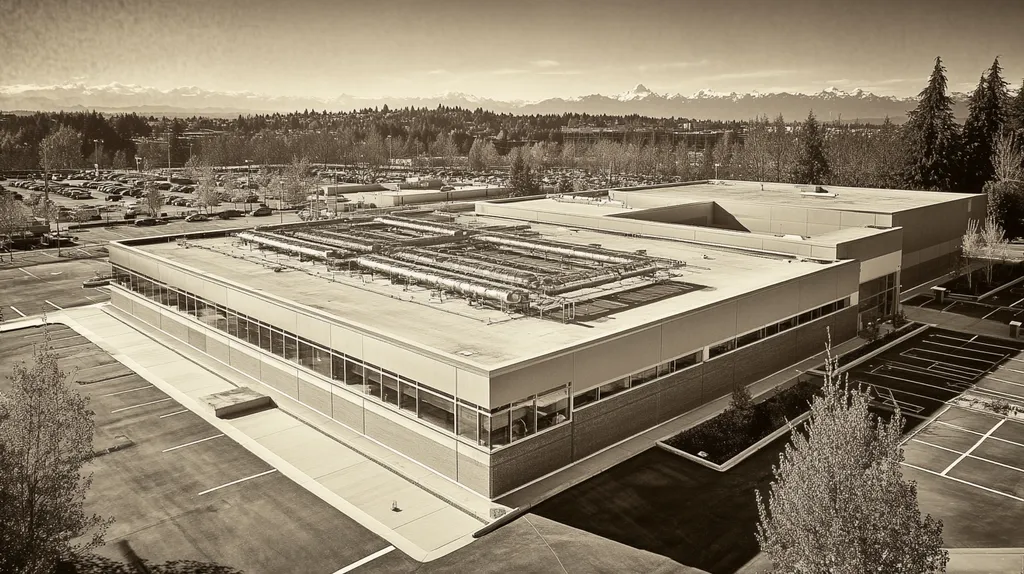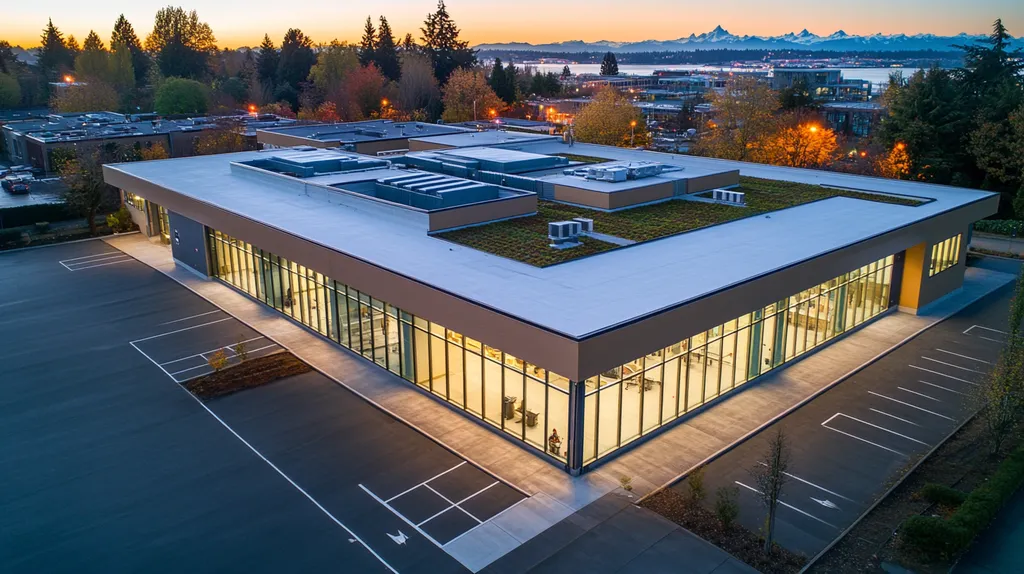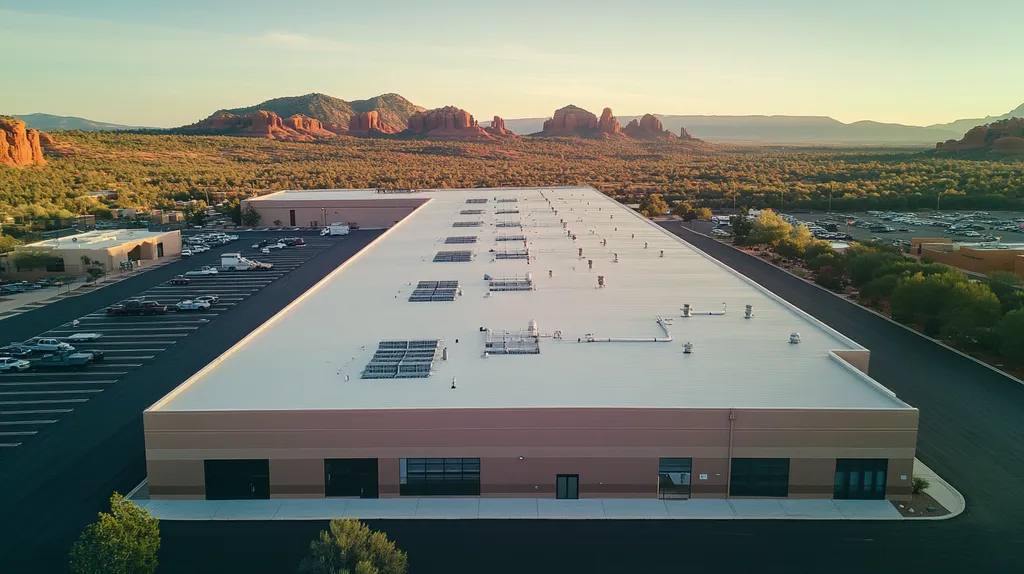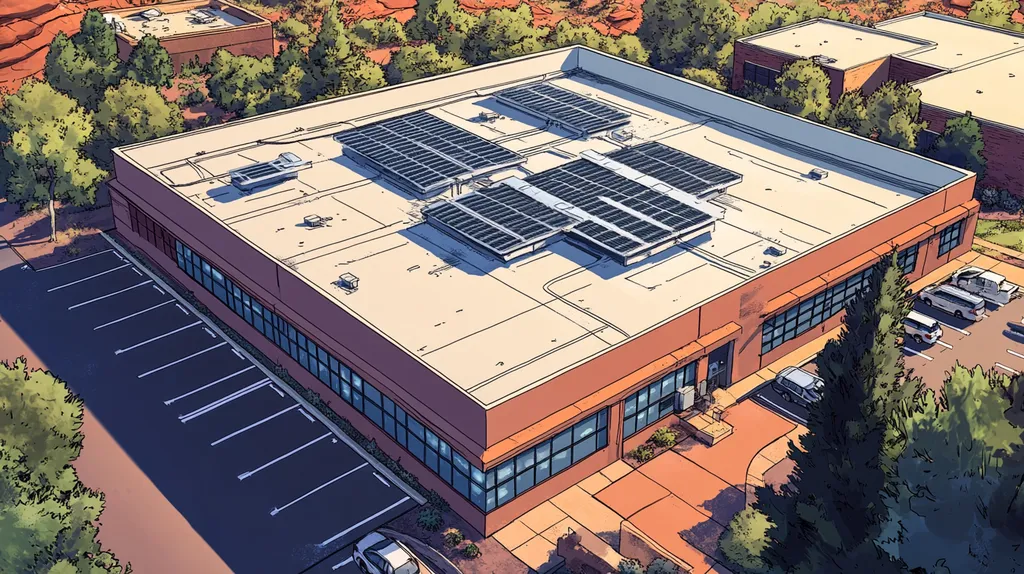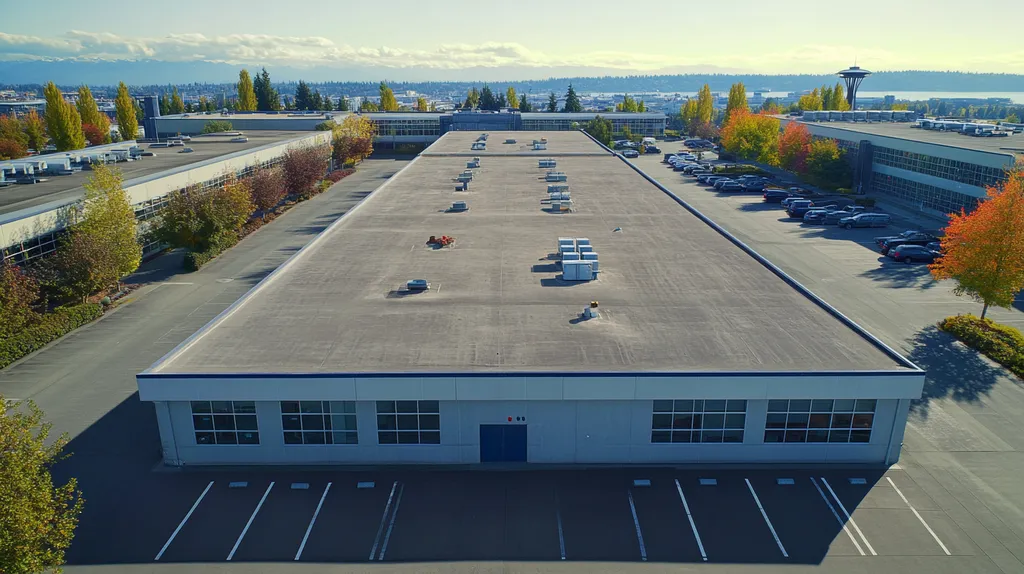Welcome to today’s Battle Royale featuring two roofing heavyweights: “TPO” in the east corner versus “EPDM” in the west!
Tonight’s showdown pits these contenders against each other across six punishing rounds designed to test every aspect of their performance for Commercial Roofing Installation Timeline.
At stake? Millions in potential costs, decades of building protection, and the critical performance demands of modern commercial and industrial facilities.
Our professional judging panel will evaluate each round on technical merit, real-world performance, and value delivery. After all six rounds, we’ll declare our ultimate champion.
Ladies and gentlemen, facility managers and building owners… it’s time to rumble!
ROUND 1: INITIAL COSTS & INSTALLATION
When it comes to commercial roofing, the timeline from project start to completion can make or break a business’s operations. Every day of installation means potential disruption to normal business activities, with studies showing that extended roofing projects can reduce retail sales by up to 25% during construction. Understanding the factors that influence installation speed – from material costs to complexity – is crucial for making an informed decision between TPO and EPDM roofing systems.
Material Expenses
Initial material costs create the foundation for project budgeting and can significantly impact overall timeline decisions. TPO materials typically cost between $3.50-$5.50 per square foot installed, representing a mid-range option in the commercial roofing market.
EPDM materials generally run slightly higher, averaging $4.00-$6.00 per square foot installed, though prices can vary based on membrane thickness and regional availability.
While both materials offer competitive pricing, TPO’s lower average cost point provides more flexibility in allocating budget resources to other aspects of installation, potentially enabling faster project completion through additional labor or equipment.
Installation Complexity
The complexity of installation directly affects how quickly a roof can be completed and put into service. TPO installation benefits from hot-air welded seams that create strong, immediate bonds, allowing for rapid project progression.
EPDM installation requires adhesive-based seaming that needs specific temperature conditions and curing time. This additional complexity can extend the installation process by 1-2 days compared to TPO.
Commercial roof installations can range from a few days to several weeks, with material choice significantly influencing the timeline. TPO’s simpler installation process typically results in faster completion times compared to EPDM. (source: NA Roofing)
Project Timeline
The overall project timeline combines material availability, installation requirements, and weather considerations. TPO projects typically complete 20-30% faster than comparable EPDM installations, primarily due to their simplified seaming process.
Weather plays a crucial role in installation speed, with TPO offering more flexibility in varying conditions. While EPDM requires specific temperature ranges for adhesive curing, TPO’s heat-welded seams can be completed in a broader range of weather conditions.
TPO’s faster installation process and greater weather flexibility translate to shorter project timelines, reducing business disruption and allowing for quicker return to normal operations.
ROUND 1 WINNER: TPO
ROUND 2: DURABILITY & LIFESPAN
When a commercial roof fails prematurely, the consequences ripple through every aspect of business operations. Failed roofs can lead to inventory damage, equipment destruction, and forced business closures that cost companies millions in lost revenue. Recent studies show that unexpected roof replacements can cost 35% more than planned installations, making the durability battle between TPO and EPDM a critical decision point for property owners.
Material Resistance and Performance
TPO membranes excel in harsh environments, featuring superior resistance to UV radiation, chemical exposure, and puncture damage. Their heat-welded seams create a monolithic surface that maintains integrity even under extreme temperature fluctuations.
EPDM’s rubber-based composition offers exceptional flexibility and thermal stability, particularly in colder climates. However, its seam adhesives can deteriorate over time, creating potential weak points in the system’s defensive capabilities.
While both materials demonstrate impressive durability, TPO’s advanced polymer technology and superior seam strength give it a clear performance advantage in most commercial applications. The material’s resistance to environmental stressors translates to fewer repair needs and longer service life.
Weather Impact Resistance
TPO roofing systems feature highly reflective surfaces that minimize UV damage and heat absorption. This reflective property reduces thermal stress on the membrane, helping maintain structural integrity through extreme temperature cycles.
EPDM performs consistently in varying weather conditions but absorbs more heat due to its dark coloring. This absorption can accelerate aging and potentially reduce service life in warmer climates, though the material excels in colder regions.
The weather resistance comparison reveals TPO’s advantage in most climate zones, with its reflective properties providing superior protection against thermal stress and UV degradation.
Long-term Value and Lifecycle Costs
TPO roofing systems typically deliver 20-25 years of service with proper maintenance. Their resistance to dirt accumulation and simpler repair procedures translate to lower maintenance costs over the roof’s lifetime.
EPDM systems can last 20-30 years but often require more frequent maintenance interventions. The material’s vulnerability to mechanical damage and seam degradation can increase long-term ownership costs.
While both systems offer impressive longevity, TPO’s combination of durability and lower maintenance requirements provides better long-term value for most commercial applications.
ROUND 2 WINNER: TPO
ROUND 3: PERFORMANCE FACTORS
Every day of roofing work exposes businesses to potential disruptions and weather risks. Understanding how different roofing materials perform during and after installation can mean the difference between a smooth project and costly delays. Recent data shows that poor material performance can extend installation timelines by up to 40%, making the choice between TPO and EPDM critical for project success.
Weather Resistance
Weather resistance directly impacts installation speed and project completion. TPO’s heat-welded seams can be installed effectively across a broader range of temperatures, allowing work to continue under varied conditions.
EPDM requires specific temperature ranges for proper adhesive curing, which can lead to installation delays during temperature extremes. This sensitivity to weather conditions often requires careful scheduling and can extend project timelines.
TPO projects consistently finish faster due to their superior weather adaptability. According to United Contracting Group, TPO installations typically complete in 3-5 days compared to 4-6 days for EPDM, largely due to TPO’s simpler application methods and reduced weather constraints. (source: United Contracting Group)
Durability
A roof’s durability affects both installation speed and long-term performance. TPO’s reinforced membrane allows installers to work more efficiently without fear of material damage, reducing installation time while maintaining quality.
EPDM’s rubber composition provides excellent puncture resistance but requires more careful handling during installation. This need for additional care can slow down the installation process.
While both materials offer strong durability, TPO’s balanced strength and workability give it an advantage in maintaining efficient installation schedules.
Installation Flexibility
Installation flexibility determines how quickly crews can adapt to site conditions and challenges. TPO’s lightweight nature and mechanical fastening options provide multiple installation methods, allowing crews to choose the most efficient approach for each project.
EPDM’s heavier weight and adhesive requirements limit installation options, potentially extending project timelines when site conditions aren’t ideal. These limitations can significantly impact overall project duration.
TPO’s superior installation flexibility translates to faster completion times and fewer weather-related delays, making it the clear winner in this category.
ROUND 3 WINNER: TPO
ROUND 4: MAINTENANCE REQUIREMENTS
Maintenance decisions impact more than just roof longevity – they directly affect a business’s bottom line. Industry data shows that poorly maintained commercial roofs fail up to 8 years earlier than well-maintained systems, leading to premature replacement costs exceeding $250,000 for typical commercial buildings. Understanding the maintenance requirements of TPO versus EPDM can prevent costly failures and protect valuable business operations.
Regular Inspection Requirements
TPO roofing systems typically require bi-annual professional inspections focused on seam integrity and surface condition. The material’s white surface makes damage identification straightforward, allowing maintenance teams to spot potential issues before they become major problems.
The heat-welded seams of TPO rarely require maintenance intervention when properly installed. This reduced maintenance burden at connection points significantly lowers the risk of water infiltration and subsequent damage.
EPDM systems demand quarterly inspections due to their reliance on adhesive-based seams. The black surface can mask damage and deterioration, making thorough inspections more time-consuming and complex.
EPDM seams require regular evaluation and often need resealing every 7-10 years, creating additional maintenance costs and potential failure points. TPO holds a clear ADVANTAGE in inspection requirements.
Cleaning and Surface Maintenance
TPO membranes feature a smooth surface that naturally resists dirt accumulation and biological growth. Simple pressure washing with standard cleaning solutions effectively maintains the surface without risking membrane damage.
The reflective properties of TPO help maintain its clean appearance longer, reducing the frequency of necessary cleaning interventions. Most TPO roofs require only annual cleaning in normal conditions.
EPDM’s porous surface tends to accumulate dirt and organic matter more readily. The material requires specialized cleaning solutions and techniques to avoid degrading the rubber compound.
The dark color of EPDM makes it more susceptible to heat absorption and weathering, necessitating more frequent cleaning and maintenance. TPO demonstrates an ADVANTAGE in surface maintenance requirements.
Repair Procedures
TPO repairs can typically be completed using heat-welding techniques that create seamless bonds. This approach ensures repairs match the original membrane strength without creating weak points.
Most TPO repairs require minimal surface preparation and can be completed quickly, reducing maintenance downtime and associated costs. The material’s consistency makes matching repairs visually unnoticeable.
EPDM repairs rely heavily on adhesives and patches that may create visible seams. These repair areas often require more extensive surface preparation and longer curing times.
The rubber-based composition of EPDM can make achieving perfect repair bonds challenging, especially in older installations. TPO shows an ADVANTAGE in repair procedures.
ROUND 4 WINNER: TPO
ROUND 5: SUSTAINABILITY CREDENTIALS
In today’s climate-conscious market, roofing choices directly impact both environmental footprint and operational costs. Studies show commercial buildings account for nearly 40% of U.S. energy consumption and carbon emissions. With increasing regulatory pressure and rising energy costs, selecting sustainable roofing materials has become a critical business decision that affects both environmental compliance and long-term operational expenses.
Environmental Impact
TPO’s highly reflective white surface significantly reduces cooling loads in commercial buildings. Studies indicate TPO roofs can lower peak cooling demand by up to 30% compared to dark surfaces, translating to substantial energy savings and reduced carbon emissions.
TPO membranes contain no plasticizers or chlorinated ingredients, making them environmentally safer during both installation and their service life. Their clean manufacturing process produces minimal waste and requires less energy than traditional roofing materials.
EPDM’s dark surface absorbs significantly more solar radiation, increasing building cooling requirements and energy consumption. While EPDM is durable, its heat absorption properties can contribute to urban heat island effects in densely developed areas.
Given its superior energy efficiency and reduced environmental impact during manufacturing, TPO demonstrates a clear ADVANTAGE in environmental performance.
Material Composition
TPO membranes are manufactured using thermoplastic polyolefin, which requires less raw material and energy to produce than traditional roofing materials. The material can be repeatedly heated and cooled without degradation, making it ideal for recycling.
The manufacturing process for TPO generates fewer volatile organic compounds (VOCs) compared to other commercial roofing options. This reduces both environmental impact and potential health risks during installation.
EPDM production relies heavily on petroleum-based materials, contributing to fossil fuel consumption. While the material itself is inert and stable, its manufacturing process has a larger carbon footprint.
TPO’s more sustainable manufacturing process and reduced reliance on petroleum products gives it an ADVANTAGE in material composition.
End-of-Life Management
Commercial roofs generally require replacement every 20-30 years, making their disposal impact a significant environmental consideration. TPO’s thermoplastic nature allows it to be fully recycled into new roofing materials or other products.
The recycling process for TPO is well-established, with many manufacturers offering take-back programs. This closed-loop system significantly reduces landfill waste and supports circular economy initiatives.
EPDM can technically be recycled, but the infrastructure for doing so is limited. Most EPDM roofing material ends up in landfills, where it takes decades to decompose.
The superior recyclability and established recycling programs for TPO create an ADVANTAGE in end-of-life management.
ROUND 5 WINNER: TPO
ROUND 6: SPECIALIZED APPLICATIONS
In specialized commercial roofing applications, installation timeline missteps can cascade into catastrophic delays and cost overruns. Recent industry data shows that specialized installations gone wrong extend project timelines by up to 400% and increase costs by $150,000 or more. For buildings with unique requirements like manufacturing facilities, data centers, or food processing plants, choosing the wrong roofing system can create operational disruptions that cost thousands per hour.
Complex Roof Structures
Buildings with intricate designs, multiple penetrations, or unusual geometries demand roofing systems that can adapt quickly while maintaining installation efficiency. These complex structures often include HVAC systems, solar installations, and specialized equipment that must be properly integrated during the roofing process.
TPO’s flexibility and heat-weldable properties allow installers to efficiently handle complex details and unusual shapes. The material can be cut, shaped, and welded around obstacles without compromising seam integrity or installation speed.
EPDM requires more time-consuming adhesive applications and manual fitting around complex features. The material’s heavy weight and reliance on adhesive bonds can significantly slow installation progress when working with intricate roof designs.
TPO’s superior workability and faster detail work give it a clear ADVANTAGE in complex roof applications.
Environmental Adaptations
Different climate zones and environmental conditions require specific installation adaptations that can impact project timelines. Coastal areas, high-altitude locations, and regions with extreme temperature variations present unique challenges for roofing installations.
TPO installations maintain consistent speed across varied environments due to their heat-welded seams and mechanical attachment options. The material’s chemical resistance also eliminates the need for additional protective measures in industrial areas.
EPDM performs reliably in extreme temperatures and harsh environments but requires careful adhesive application timing. The material’s proven track record in challenging environments balances its longer installation requirements.
Both materials offer unique environmental benefits, resulting in a TIE for this category.
Equipment Integration
Modern commercial roofs must accommodate an increasing array of equipment while maintaining watertight integrity. Solar panels, satellite dishes, and industrial ventilation systems all require secure attachment points that don’t compromise the roofing system.
TPO’s reinforced membrane and heat-welded flashings allow for rapid equipment integration. The material’s strength permits direct attachment of mounting systems without requiring additional reinforcement layers.
EPDM installations typically need extra reinforcement and protection layers around equipment mounts. The additional steps and materials required for secure equipment integration extend installation timelines significantly.
TPO demonstrates a clear ADVANTAGE in equipment integration efficiency.
ROUND 6 WINNER: TPO
AND THE WINNER IS…
Ladies and gentlemen, after six grueling rounds of technical evaluation, we have our verdict. In a dominant performance that showcased superior speed, strength, and sustainability, TPO has emerged as our undisputed champion!
TPO claimed victory in all six rounds, demonstrating exceptional prowess in installation timelines, durability, performance factors, maintenance requirements, sustainability credentials, and specialized applications. Its heat-welded seams, weather flexibility, and rapid installation capabilities delivered a knockout combination that couldn’t be matched.
But don’t count EPDM out completely! This seasoned veteran still proves formidable in extreme cold weather applications and when maximum puncture resistance is required. Its proven track record in northern climates makes it a worthy contender for specific applications.
*Important Notice: Every building represents a unique challenge with distinct requirements. Local climate conditions, building codes, and specific property characteristics all play crucial roles in roofing system selection. This analysis provides general guidance but cannot account for all variables. Always consult qualified roofing professionals who can evaluate your specific situation before making final decisions.
In the high-stakes arena of commercial roofing, there’s no room for split decisions. Choose your champion wisely by matching your building’s specific requirements with the right contender’s strengths. The real victory comes not just from selecting a winner, but from making an informed decision that protects your investment for decades to come.
FREQUENTLY ASKED QUESTIONS
Q. How do initial costs influence commercial roof timelines?
A. Initial costs impact project budgets, affecting the choice of materials and speed of installation. Lower material costs can allow more funds for additional labor or equipment, potentially speeding up the project. Balancing budget with quality is key to minimizing disruptions during the installation of a commercial roof.
Q. What affects the durability of an industrial roof?
A. Durability is influenced by material resistance, weather performance, and overall lifespan. TPO and EPDM both offer durability, but TPO generally performs better in harsh conditions due to its resistance to UV rays and extreme temperatures. A durable roof reduces overall maintenance costs and aids long-term operational efficiency.
Q. How do weather conditions impact commercial roof installations?
A. Weather conditions can significantly affect installation timelines by determining material handling and curing times. TPO’s heat-welded seams offer greater flexibility in various temperatures, while EPDM requires specific conditions for adhesive curing. Understanding these impacts can aid in effective project scheduling and minimize delays.
Q. What maintenance do commercial roofs require?
A. Regular inspections and maintenance are essential for extending the lifespan of a roof. TPO roofs typically need bi-annual inspections, while EPDM requires more frequent evaluations due to adhesive vulnerabilities. Proper maintenance schedules can prevent major issues and costly repairs for commercial roofs.
Q. How do sustainability credentials affect roofing choices?
A. Sustainability credentials have become vital due to rising energy costs and regulatory pressures. TPO’s reflective surface can greatly reduce energy consumption, while EPDM’s dark color absorbs heat. Choosing eco-friendly materials not only helps the environment but can also lead to significant long-term savings for businesses.
Q. How do specialized applications impact roof installation time?
A. Specialized applications often require additional planning and careful execution, which can extend installation timelines. For complex roof structures or equipment integration, TPO’s adaptability makes it a preferable choice, potentially reducing delays. Selecting suitable materials for specialized needs is crucial to avoid costly project overruns.
Q. What role does temperature play in roofing installation timelines?
A. Temperature affects material performance and bonding, impacting installation speed. TPO can be installed effectively in a wider temperature range due to its heat-welded seams, allowing for consistent work, while EPDM’s adhesive requires specific conditions. Understanding temperature effects is essential for project planning to minimize delays.

